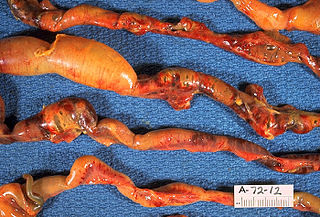Related Research Articles

A computed tomography scan is a medical imaging technique used to obtain detailed internal images of the body. The personnel that perform CT scans are called radiographers or radiology technologists.

Crohn's disease is a type of inflammatory bowel disease (IBD) that may affect any segment of the gastrointestinal tract. Symptoms often include abdominal pain, diarrhea, fever, abdominal distension, and weight loss. Complications outside of the gastrointestinal tract may include anemia, skin rashes, arthritis, inflammation of the eye, and fatigue. The skin rashes may be due to infections as well as pyoderma gangrenosum or erythema nodosum. Bowel obstruction may occur as a complication of chronic inflammation, and those with the disease are at greater risk of colon cancer and small bowel cancer.

Appendicitis is inflammation of the appendix. Symptoms commonly include right lower abdominal pain, nausea, vomiting, and decreased appetite. However, approximately 40% of people do not have these typical symptoms. Severe complications of a ruptured appendix include widespread, painful inflammation of the inner lining of the abdominal wall and sepsis.

Radiology is the medical discipline that uses medical imaging to diagnose diseases and guide their treatment, within the bodies of humans and other animals. It began with radiography, but today it includes all imaging modalities, including those that use no electromagnetic radiation, as well as others that do, such as computed tomography (CT), fluoroscopy, and nuclear medicine including positron emission tomography (PET). Interventional radiology is the performance of usually minimally invasive medical procedures with the guidance of imaging technologies such as those mentioned above.

Medical imaging is the technique and process of imaging the interior of a body for clinical analysis and medical intervention, as well as visual representation of the function of some organs or tissues (physiology). Medical imaging seeks to reveal internal structures hidden by the skin and bones, as well as to diagnose and treat disease. Medical imaging also establishes a database of normal anatomy and physiology to make it possible to identify abnormalities. Although imaging of removed organs and tissues can be performed for medical reasons, such procedures are usually considered part of pathology instead of medical imaging.

Bowel obstruction, also known as intestinal obstruction, is a mechanical or functional obstruction of the intestines which prevents the normal movement of the products of digestion. Either the small bowel or large bowel may be affected. Signs and symptoms include abdominal pain, vomiting, bloating and not passing gas. Mechanical obstruction is the cause of about 5 to 15% of cases of severe abdominal pain of sudden onset requiring admission to hospital.

An upper gastrointestinal series, also called a barium swallow, barium study, or barium meal, is a series of radiographs used to examine the gastrointestinal tract for abnormalities. A contrast medium, usually a radiocontrast agent such as barium sulfate mixed with water, is ingested or instilled into the gastrointestinal tract, and X-rays are used to create radiographs of the regions of interest. The barium enhances the visibility of the relevant parts of the gastrointestinal tract by coating the inside wall of the tract and appearing white on the film. This in combination with other plain radiographs allows for the imaging of parts of the upper gastrointestinal tract such as the pharynx, larynx, esophagus, stomach, and small intestine such that the inside wall lining, size, shape, contour, and patency are visible to the examiner. With fluoroscopy, it is also possible to visualize the functional movement of examined organs such as swallowing, peristalsis, or sphincter closure. Depending on the organs to be examined, barium radiographs can be classified into "barium swallow", "barium meal", "barium follow-through", and "enteroclysis". To further enhance the quality of images, air or gas is sometimes introduced into the gastrointestinal tract in addition to barium, and this procedure is called double-contrast imaging. In this case the gas is referred to as the negative contrast medium. Traditionally the images produced with barium contrast are made with plain-film radiography, but computed tomography is also used in combination with barium contrast, in which case the procedure is called "CT enterography".

Virtual colonoscopy is the use of CT scanning or magnetic resonance imaging (MRI) to produce two- and three-dimensional images of the colon, from the lowest part, the rectum, to the lower end of the small intestine, and to display the images on an electronic display device. The procedure is used to screen for colon cancer and polyps, and may detect diverticulosis. A virtual colonoscopy can provide 3D reconstructed endoluminal views of the bowel. VC provides a secondary benefit of revealing diseases or abnormalities outside the colon.

Diatrizoate, also known as amidotrizoate, Gastrografin, is a contrast agent used during X-ray imaging. This includes visualizing veins, the urinary system, spleen, and joints, as well as computer tomography. It is given by mouth, injection into a vein, injection into the bladder, through a nasogastric tube, or rectally.

Pneumatosis intestinalis is pneumatosis of an intestine, that is, gas cysts in the bowel wall. As a radiological sign it is highly suggestive for necrotizing enterocolitis. This is in contrast to gas in the intestinal lumen. In newborns, pneumatosis intestinalis is considered diagnostic for necrotizing enterocolitis, and the gas is produced by bacteria in the bowel wall. The pathogenesis of pneumatosis intestinalis is poorly understood and is likely multifactorial. PI itself is not a disease, but rather a clinical sign. In some cases, PI is an incidental finding, whereas in others, it portends a life-threatening intra-abdominal condition.

Omental cake is a radiologic sign indicative of an abnormally thickened greater omentum. It refers to infiltration of the normal omental structure by other types of soft-tissue or chronic inflammation resulting in a thickened, or cake-like appearance.

Computed tomography angiography is a computed tomography technique used for angiography—the visualization of arteries and veins—throughout the human body. Using contrast injected into the blood vessels, images are created to look for blockages, aneurysms, dissections, and stenosis. CTA can be used to visualize the vessels of the heart, the aorta and other large blood vessels, the lungs, the kidneys, the head and neck, and the arms and legs. CTA can also be used to localise arterial or venous bleed of the gastrointestinal system.

A CT pulmonary angiogram (CTPA) is a medical diagnostic test that employs computed tomography (CT) angiography to obtain an image of the pulmonary arteries. Its main use is to diagnose pulmonary embolism (PE). It is a preferred choice of imaging in the diagnosis of PE due to its minimally invasive nature for the patient, whose only requirement for the scan is an intravenous line.

An abdominal x-ray is an x-ray of the abdomen. It is sometimes abbreviated to AXR, or KUB.

High-resolution computed tomography (HRCT) is a type of computed tomography (CT) with specific techniques to enhance image resolution. It is used in the diagnosis of various health problems, though most commonly for lung disease, by assessing the lung parenchyma. On the other hand, HRCT of the temporal bone is used to diagnose various middle ear diseases such as otitis media, cholesteatoma, and evaluations after ear operations.

Contrast CT, or contrast enhanced computed tomography (CECT), is X-ray computed tomography (CT) using radiocontrast. Radiocontrasts for X-ray CT are generally iodine-based types. This is useful to highlight structures such as blood vessels that otherwise would be difficult to delineate from their surroundings. Using contrast material can also help to obtain functional information about tissues. Often, images are taken both with and without radiocontrast. CT images are called precontrast or native-phase images before any radiocontrast has been administered, and postcontrast after radiocontrast administration.

Coronary CT angiography is the use of computed tomography (CT) angiography to assess the coronary arteries of the heart. The patient receives an intravenous injection of radiocontrast and then the heart is scanned using a high speed CT scanner, allowing physicians to assess the extent of occlusion in the coronary arteries, usually in order to diagnose coronary artery disease.

Computed tomography of the abdomen and pelvis is an application of computed tomography (CT) and is a sensitive method for diagnosis of abdominal diseases. It is used frequently to determine stage of cancer and to follow progress. It is also a useful test to investigate acute abdominal pain. Renal stones, appendicitis, pancreatitis, diverticulitis, abdominal aortic aneurysm, and bowel obstruction are conditions that are readily diagnosed and assessed with CT. CT is also the first line for detecting solid organ injury after trauma.
Magnetic resonance enterography is a magnetic resonance imaging technique used to evaluate bowel wall features of both upper and lower gastro-intestinal tract, although it is usually used for small bowel evaluation. It is a less invasive technique with the advantages of no ionizing radiation exposure, multiplanarity and high contrast resolution for soft tissue.

Emilio Quaia is an Italian radiologist, academic, and author. He is a Professor of Radiology and the Director of the Radiology Department at the University of Padova.
References
- ↑ Diseases of the abdomen and pelvis 2010-2013 : diagnostic imaging and interventional techniques. Jürg Hodler, Gustav Konrad von Schulthess, Ch. L. Zollikofer, International Diagnostic Course in Davos, Nuclear Medicine Statellite Course '"Diamond", Pediatric Satellite Course "Kangaroo". Milano. 2010. ISBN 978-88-470-1637-8. OCLC 697276986.
{{cite book}}: CS1 maint: location missing publisher (link) CS1 maint: others (link) - ↑ Image processing in radiology : current applications. E. Neri, D. Caramella, C. Bartolozzi. Berlin: Springer. 2008. ISBN 978-3-540-25915-2. OCLC 233973111.
{{cite book}}: CS1 maint: others (link) - 1 2 3 4 5 Dave-Verma, Hetal; Moore, Scott; Singh, Ajay; Martins, Noel; Zawacki, John (November 2008). "Computed Tomographic Enterography and Enteroclysis: Pearls and Pitfalls". Current Problems in Diagnostic Radiology. 37 (6): 279–287. doi:10.1067/j.cpradiol.2007.08.007. PMID 18823868.
- ↑ Bhatt, Shuchi; Roy, Satarupa; Bhardwaj, Naveen; Tandon, Anupama; Singh, Vikas Kumar; Jain, Bhupender Kumar; Mandal, Samrat (2017). "Kaleidoscopic View of Bowel Tuberculosis on Multi- Detector Computed Tomography (CT) Enterography – A Novel Technique Unfolding an Archaic Disease". Polish Journal of Radiology. 82: 783–791. doi:10.12659/PJR.903473. ISSN 1899-0967. PMC 5894039 . PMID 29657645.
- 1 2 3 4 5 6 7 8 Paulsen, Scott R.; Huprich, James E.; Fletcher, Joel G.; Booya, Fargol; Young, Brett M.; Fidler, Jeff L.; Johnson, C. Daniel; Barlow, John M.; Earnest, Franklin (May 2006). "CT Enterography as a Diagnostic Tool in Evaluating Small Bowel Disorders: Review of Clinical Experience with over 700 Cases". RadioGraphics. 26 (3): 641–657. doi: 10.1148/rg.263055162 . ISSN 0271-5333. PMID 16702444.
- 1 2 3 4 5 Park, Seong Ho; Ye, Byong Duk; Lee, Tae Young; Fletcher, Joel G. (September 2018). "Computed Tomography and Magnetic Resonance Small Bowel Enterography". Gastroenterology Clinics of North America. 47 (3): 475–499. doi:10.1016/j.gtc.2018.04.002. PMID 30115433. S2CID 52019244.
- 1 2 3 Elsayes, Khaled M.; Al-Hawary, Mahmoud M.; Jagdish, Jagalpathy; Ganesh, Halemane S.; Platt, Joel F. (November 2010). "CT Enterography: Principles, Trends, and Interpretation of Findings". RadioGraphics. 30 (7): 1955–1970. doi: 10.1148/rg.307105052 . ISSN 0271-5333. PMID 21057129.
- ↑ Bruining, David H.; Zimmermann, Ellen M.; Loftus, Edward V.; Sandborn, William J.; Sauer, Cary G.; Strong, Scott A.; Al-Hawary, Mahmoud; Anupindi, Sudha; Baker, Mark E.; Bruining, David; Darge, Kassa (March 2018). "Consensus Recommendations for Evaluation, Interpretation, and Utilization of Computed Tomography and Magnetic Resonance Enterography in Patients With Small Bowel Crohn's Disease". Gastroenterology. 154 (4): 1172–1194. doi:10.1053/j.gastro.2017.11.274. PMID 29329905.